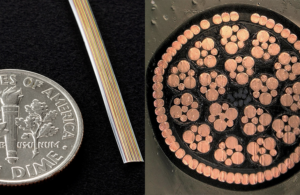
The increasingly sophisticated catheters — small and flexible — can better send diagnostic signals into the body or provide therapy, according to Mike Winterling, VP of business development at Junkosha USA. (Winterling wrote a description of the products for Medical Tubing + Extrusion and Medical Design & Outsourcing.)
“Solutions such as the Junkosha Multi-Filar Cable and Junkosha Multi-Channel Transmission Cable (MCT) represent a breakthrough in the design of medical device cables that take us one step closer on the journey to the next generation of these important devices,” Winterling said.
The Junkosha Multi-Filar Cable could help because it has a capacity of up to 64 channels, depending on AWG size or pitch. Junkosha designed the cable to provide multiple signals through an ultra-small shaft.
Precision-engineered PTFE lamination technology enables single-strand configurations joined into a multi-filar assembly. Junkosha officials see potential uses in electrophysiology catheters for applying pacing and recording data from inside the heart, ablation catheters for treating atrial fibrillation and cardiac mapping.
The multi-filar technique also allows for easier assembly of the signal or power wires into the final medical device.
“The bond strength between the individual strands can be adjusted to maximize strength for challenging assembly conditions or optimized for difficult separation processes,” Winterling said. “Multi-filar configurations allow for joining dissimilar single strand alloys together in one package, which is perfectly suited for applications like thermocouples, micro-cables that need a high strength member for load-bearing or other assembly operations.”
The Junkosha Multi-Channel Transmission Cable (MCT) meanwhile improves on existing twisted pair, coaxial and flexible printed circuit technology. It allows for the utilization of new data-rich signals in therapies such as intracardiac echocardiography (ICE), endoscopic ultrasound (EUS) and intravascular ultrasound (IVUS).
Existing catheters rely on micro-coaxial constructs to support an increasing number of signals within the device, according to Winterling. He said the standard coaxial approach but is now facing challenges related to miniaturization and flexibility.
“Physics and electromagnetics have prevented the development of smaller cables and limited catheter flexibility,” Winterling said. “In contrast, the new Junkosha MCT cable design uses a patented configuration of microwires that are individually insulated with an innovative shielding/grounding construct which improves signal integrity and increases signal capacity for a given size. While the traditional catheter with coaxial cables requires one cable for each signal, MCT enables multiples of four signals to be brought together into one cable, therefore significantly increasing the signal capacity per unit diameter.”
Early prototypes with AWG 44 conductors have achieved a 32% reduction in cable size compared to traditional micro-coax construction, according to Winterling. “The MCT approach also provides greater flexibility compared to flexible printed circuit board (FPC) designs, which promises major advances in the scope of these medical procedures.”
